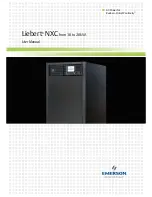
ABB Distribution Protection Unit 1500R
6-9
Programmable Input and Output Contacts
9/99
website:www.abb.com/papd
KSI:
KSI Summation Alarm. Activates when the KSI sum has exceeded the KSI Counter Alarm
setting.
PDA:
Phase Current Demand Alarm. Activates when the demand current for any phase has
exceeded the Phase Demand Alarm setting. This alarm is based on the incremental
demand values and not the instantaneous values as in the load alarms. When the demand
value rises above the Phase Demand Alarm setting, a 60 second timer is started. When
the timer expires, PDA becomes a logical 1.
NDA:
Neutral Current Demand Alarm. Operates when the demand current for the neutral input
has exceeded the Neutral Demand Alarm setting. This alarm is based on the incremental
demand values and not the instantaneous values as in the load alarms. When the demand
value rises above the Neutral Demand Alarm setting, a 60 second timer is started. When
the timer expires, NDA becomes a logical 1.
PVArA:
Positive 3 Phase kiloVAr Alarm. Operates 60 seconds after the positive 3 phase kiloVArs
exceed the Positive KiloVAr Alarm setting. When the Positive KiloVAr value rises above
the the Positive KiloVAr Alarm setting, a 60 second timer is started. When the timer
expires, PVArA becomes a logical 1. If the value drops below the Alarm setting before the
60 second timer expires, the timer will reset.
NVArA:
Negative 3 Phase kiloVAr Alarm. Operates 60 seconds after the negative 3 phase kiloVArs
exceed the Negative KiloVAr Alarm setting. When the Negative KiloVAr value rises above
the the Negative KiloVAr Alarm setting, a 60 second timer is started. When the timer
expires, NVArA becomes a logical 1. If the value drops below the Alarm setting before the
60 second timer expires, the timer will reset.
LOADA:
Load Current Alarm. Operates 60 seconds after any single phase of load current rises
above the Load Alarm setting. If the value drops below the Alarm setting before the 60
second timer expires, the timer will reset.
50-1D:
50-1 Instantaneous Overcurrent Disabled Alarm. Operates when the torque controlled
Programmable Input, 50-1, is mapped but not energized. This alarm indicates that the 50P-
1 instantaneous unit is disabled form tripping. 50-1D will not operate if the 50P-1 element
is disabled in the protective settings.
LPFA:
Low Power Factor Alarm. Operates 60 seconds after the load power factor drops below
the Power Factor Alarm setting. If the value drops below the Alarm setting before the 60
second timer expires, the timer will reset.
HPFA:
High Power Factor Alarm. Operates 60 seconds after the power factor rises above the
Power Factor Alarm setting. If the value drops below the Alarm setting before the 60
second timer expires, the timer will reset.
ZSC:
Zone Sequence Coordination Enabled Indicator. Operates when the Zone Sequence
function is active. ZSC will be a logical 1 when Zone Sequence is enabled in the
“Configurations” menu and the ZSC programmable input (see Programmable Inputs Section)
is not assigned to an input or feedback term. ZSC will also be a logical 1 if the ZSC
programmable input is assigned to an input or feedback term and that input or feedback
term is energized. If any one of these conditions is not true ZSC will be a logical 0.
50-2D:
50-2 Instantaneous Overcurrent Disabled Alarm. Operates when the torque control
Programmable Input, 50-2, is mapped but not energized. This alarm indicates that the 50P-
2 instantaneous unit is disabled form tripping. 50-2D will not operate if the 50P-2 element
is disabled in the protective settings.
BFUA:
Blown Fuse Alarm. Operates when the voltage of any phase or phases drops below 7
volts and no 51P or 51N overcurrent pickup condition exists. This Logical Output seals in
after a blown fuse condition exists. It must be manually reset via the MMI or WinECP after
voltage has been restored.
Table 6-2: Logical Output Definitions (cont).
(I>TC)
(I>>1D)
(I>>2D)













































